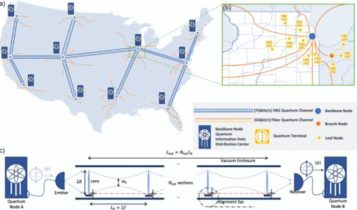A Fast, Cross-Country Quantum Network Now?
To date, there hasn’t been a practical method of building quantum networks that can transmit quantum information over long distances. However, building a country-wide quantum network using vacuum beam guides may be possible, enabling qubits to travel thousands of miles inside small vacuum-sealed tubes.
Researchers at the University of Chicago Pritzker School of Molecular Engineering (PME) have developed this new approach. They want to build long quantum channels using vacuum-sealed tubes featuring an array of spaced-out lenses. The vacuum beam guides would have ranges of thousands of kilometers and capacities of more than 1013 qubits per second. Photons of light encoding quantum data would move through the vacuum tubes and be focused thanks to the lenses.
According to Liang Jiang, professor of molecular engineering, “It could not only be used for secure communication, but also for building distributed quantum computing networks, distributed quantum sensing technologies, new kinds of telescopes, and synchronized clocks.” Jiang collaborated with scientists at Stanford University and the California Institute of Technology on the new work, published in Physical Review Letters.
The team wanted to combine what worked well with each of the previous approaches. They found that, within a vacuum, it’s possible to send a lot of information without attenuation. Being able to do that on the ground is ideal.

Scientists working at the Laser Interferometer Gravitational-Wave Observatory (LIGO) the California Institute of Technology built huge ground-based vacuum tubes to contain moving photons of light to detect gravitational waves. Inside a nearly-molecule-free vacuum, photons can travel for thousands of kilometers. The team sketched out how smaller vacuum tubes could transport photons between quantum computers. Their new theoretical work showed that the tubes could carry photons across the country.
“The main challenge is that as a photon moves through a vacuum, it spreads out a bit,” explained Jiang. “To overcome that, we propose putting lenses every few kilometers that can focus the beam over long distances without diffraction loss.”
The group is planning tabletop experiments to test the idea’s practicality and then plans to use larger vacuum tubes, such as those at LIGO, to work on aligning the lenses and stabilizing the photon beams over long distances.

